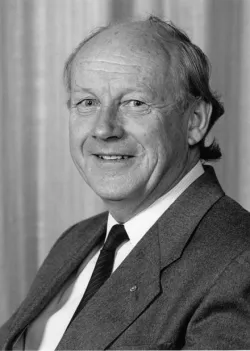Professor David Curtis
David Curtis, a Melbourne-born medical researcher, made significant contributions to the field of neurophysiology, particularly in identifying amino acids as major central transmitters and investigating the pharmacological properties of synaptic boutons, and he held prestigious positions in scientific administration.

David Curtis, born in Melbourne, completed his medical course at the University of Melbourne in October 1950. After three years clinical experience, mainly in neurology and neurosurgery, he moved to Canberra in February 1954 to take up a Research Scholarship in the Department of Physiology, John Curtin School under the supervision of Professor JC Eccles.
His involvement in investigations of synaptic excitation and inhibition in the spinal cord led in 1957 to the development of a technique for combining the recording of extracellular or intracellular potentials of single, physiologically identified neurones with the direct administration of compounds of pharmacological interest into their immediate vicinity. Using this technique, called microelectrophoresis, the ability to mimic, antagonize or enhance the action of transmitters released at synapses within the intact central nervous system enabled the identification of the transmitters of particular excitatory and inhibitory pathways in the spinal cord and brain.
Following their initial observation in 1958 that aminoacids present in the mammalian brain modified the excitability of neurones, Curtis and his colleagues, particularly JC Watkins and GAR Johnston, were significant contributors to the eventual acceptance that aminoacids were major central transmitters: glycine and 4-aminobutyric acid (GABA) at inhibitory synapses and aspartic and glutamic acids at excitatory synapses.The use of strychnine and bicuculline, selective antagonists of glycine and GABA respectively, demonstrated the role of glycine as an inhibitory transmitter particularly in the spinal cord and that of GABA in the thalamus, cerebellum, hippocampus, cerebral cortex and in the spinal cord.
From 1976, Curtis and his colleagues combined microelectrophoretic and electrophysiological techniques to investigate in-vivo the pharmacological and biophysical properties of single intraspinal axons and their synaptic boutons. These studies raised questions about the functional significance of "presynaptic" inhibition in the mammalian spinal cord, a phenomenon investigated in the School since the 1960s.
Elected in 1965 to Fellowship of the Australian Academy of Science, of which he was President from 1986 to 1990, Curtis was appointed Professor of Pharmacology in the John Curtin School Department of Physiology in 1966 and Foundation Head of the Department of Pharmacology in 1973. In 1974 he was elected to Fellowship of the Royal Society of London, and from 1989 to 1992 was Director and Howard Florey Professor of Medical Research in the John Curtin School.
His contributions to medical research and scientific administration were recognized in 1992 by appointment as a Companion in the Order of Australia. Professor Curtis collaborated with Professor Frank Fenner in the demanding task of writing a history of the John Curtin School, and on 15 November 2001 the book was officially launched.
